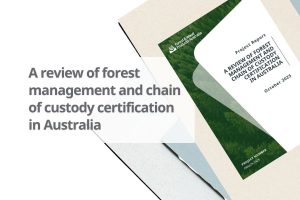Australian forestry research is about to get another boost, thanks to the announcement of funding for 10 exciting new projects.
The research will be funded following recommendations made by the Grower Research Advisory Committee (GRAC). It will cover everything from mitigating the risks posed by pests and diseases to improving geospatial accuracy, drought-proofing plantations, genomics and much more!
The 10 successful projects were selected following the submission of proposals submitted from an open call last November. Guided by recommendations of a governance working group made up of GRAC members, the GRAC Executive Committee undertook a robust evaluation of all submissions, with the assistance of a scientific advisory panel, before making its final recommendations to the FWPA Board. These recommendations included that a total investment of $11.2 million be made in support of the 10 successful projects, which were selected based on their potential to best advance the priority topics identified in FWPA’s forestry research investment plans.
The investment plans established a portfolio of research priorities across nine key themes that were considered likely to help realise GRAC’s vision, “to double the value of Australia’s commercial forests by 2040, by fostering an innovation culture in our enterprises, applying world’s best practices, collaborating and investing into research and development as appropriate.”
The committee also worked to ensure chosen projects represented a balance of investment across different forest types and geographical regions.
“We were delighted with the positive response to the open call for submissions, and the effort made to understand the research needs of the growers,” said Jodie Mason, FWPA’s Forest Research Manager.
“A key part of the evaluation process this year was review by a scientific advisory panel made up of two external members and two grower members, all with appropriate research and subject matter expertise.” The panel assessed the scientific merit of each proposal and provided advice to the GRAC Executive Committee.
“We are very pleased with the value added by the panel this year, and FWPA and growers are supportive of using a similar model next time.”
“Investment in these sorts of research projects is crucial, not only for protecting and optimising the Australian forestry resource as it stands today, but also to make sure we are ready to maximise opportunities around the new technologies and innovations that will fortify Australian forestry into the future.”
“I thank all applicants for submitting proposals and advise that we plan to announce a further call for proposals in the coming months.”
The 10 projects selected by the committee for investment are:
Forest Pest Management (FPM) Research Consortium
The University of the Sunshine Coast will oversee the continuation of a current program of forestry-specific research to control weeds and pests.
Collaboration between chemical manufacturers, forest growers and other relevant stakeholders will support everything from initial field trials right through to facilitating label registration of pesticides, outreach and extension. As a result of this project, advice and representation will also be provided to the Australian Pesticides and Veterinary Medicine Authority and state-based regulators.
Managing Teratosphaeria through resistance breeding
Gondwana Genomics will undertake a project that aims to use genomics to improve the tolerance of eucalyptus plantations to Teratosphaeria leaf disease by developing disease marker panels to be used in operational breeding programs.
Microbiome management: leveraging advances in microbiome research to deliver cost-effective tools to boost resilience and productivity of pines throughout their production lifecycle
A team at Western Sydney University will work to identify the mycorrhizal fungi most beneficial to young pine plants. They will develop tailored microbial inoculants and identify optimal fertiliser and fungicide for use in nurseries to improve seedling health and in-field survival.
Forest supply chain value optimisation
A six-month extension of existing research at the University of the Sunshine Coast will be funded, with activities designed to enable an external review and consideration of future work in the area of supply chain optimisation.
Geospatial positioning and fusion: is real-time sub-metre accuracy operationally feasible in forestry environments?
Led by the University of South Australia, this project will aim to evaluate options, offer guidance, and develop tools, standards and guidelines to help achieve the required accuracy of positioning, spatial processing, and data fusion outcomes for operational forest use.
Enhancing biological control of invasive eucalyptus weevils in Australia’s eucalypt plantations
Building on previous work, researchers at the University of the Sunshine Coast will identify host-matched, efficacious parasitoid wasp populations in the Green Triangle. Those wasps will then be released in Western Australia to help improve biological control of eucalyptus weevils in Eucalyptus globulus plantations.
Increased and sustained productivity gains in national tree improvement programs for softwood and hardwood plantations
Tree Breeding Australia will scale up its phenotyping, genotyping and tree breeding activities with the strategic goal of doubling the rate of genetic gain and bringing forward productivity increases specifically in pines and eucalypts.
Using genomics to double the rate of genetic gain in Australian forest tree improvement programs
In support of the goal of doubling the rate of genetic gain in Pinus radiata, Eucalyptus globulus, E. nitens and southern pines, Tree Breeding Australia will explore opportunities for the adoption of genomic data to enable early parent selection to reduce generation interval and increase breeding value accuracy.
Drought proofing our plantation estate — improved methods to efficiently manage water stress and productivity in a drying climate
This University of Melbourne project aims to improve the industry’s ability to manage the productivity and survival of Pinus radiata plantations in a changing climate. It will quantify interactions between spatially varying water stores, stand water use/water stress, nutrition and growth dynamics through plots of variable stocking, fertiliser rates and available water.
Enhancing the knowledge base for hardwood plantation management
McGrath Forestry Services will gather, collate and synthesise existing, emerging and under-utilised research and modelled data to improve hardwood silvicultural knowledge in slash management, fertiliser response across whole-of rotation, planting density and stocking, coppice (grown from tree cutting) and seedling establishment, and weed control effects. The work will result in a new database and further calibration of the ProFert model — a fertiliser tool for plantations in southern Australia.



